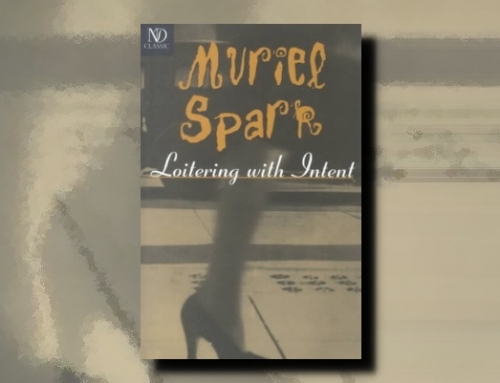Muriel Spark is in my Pantheon, my list of favorite authors (which you can see here). One of these days, I’ll have read all of her books — that’s my goal at least. I love her slick observations. She’s the very definition of “biting wit.” Her stories are usually just a bit off kilter, and thus all the more disturbing, kind of like that nice neighbor you suspect has the capacity for murder. I’m glad, however, that I didn’t start reading Spark with The Public Image (1968). It’s finely written, but for me it is a relic of its time. Indeed, I find it hard to believe it was particularly fresh timely when it came out in the late 1960s.
Incidentally, before I get any further, this was also the first book selected for this year’s Off-Season Booker read on my forum (here). Not a lot of participation, but what we got was fun and enlightening. We’ll be selecting another book soon if you’re interested.

The book begins on a peaceful Friday morning in a new flat in Rome. There are things to be done in the new home, but most things are scheduled for the coming week. Hopefully this will be a peaceful weekend for this young mother and her new baby.
The young mother is Annabel Christopher, “who in private life was Mrs. Frederick Christopher.” She’s thirty-two and tending to her first child. We first meet Annabel in this intimate domestic setting. She’s barely mindful of life outside these new walls. But then, her husband’s friend Billy arrives. He just walks in, gives her a hard time, and says, “Is this all in aid of your public image?”
Indeed, Annabel is a famous actress, known to her fans as the English Lady-Tiger. She and her husband, who wrote her most famous roles, including the one that made her the English Lady-Tiger, are a beloved couple: successful, loving, faithful. That’s their public image, at least. As we go further, we have reason to doubt how much this new, intimate home allows us to view anything under the surface.
The first third of this short novel goes back in time, showing us how Annabel and Frederick got together, back when Frederick was the successful one and Annabel was — well, in retrospect Frederick never thought she’d amount to much. And now here she is, bringing in all of this money, and under the covers of domesticity, she is absolutely not the English Tiger-Lady. As time passes, he progressively views her with bitterness and jealousy, and he knows that she’s a fraud.
He wanted to leave her, and made up his mind that he would do so, eventually. Eventually, he thought, I’ll have to go. But, in a way, he was hypnotised by a sense of the enormity of her deception, the more her reputation grew and she accepted it as part of her rightful earnings.
The disparity between public and private, and how the public begins to take over the private, is Sparks focal point here. And she allows Frederick to concoct and enact a scheme that is completely ludicrous — so ludicrous, it’s genius — to take down Annabel, ruin her public image, and, of course, her whole life.
I want to say here that I did enjoy this book. I read it with complete attention, and I am always engaged when Spark has her characters doing things no rational human being would do just to mess with someone else.
My problem with the book is its theme — the public image and how it can control and ruin someone’s life. This is a theme that had already been explored wonderfully in — where else — Rome in the early 1960s. There’s a reason Federico Fellini’s 1960 La Dolce Vita was the origination of the term “paparazzi.” It was impossible for me to read The Public Image without thinking of how the films of this era explored this all and did it better.
While the majority of this book felt overly familiar, I do feel that Spark’s addition of Frederick’s plot is purely a Spark touch. She also ends her book quite differently that most of the films that shot through my head — why, her book was almost hopeful. But I’m afraid that, for me, this hope felt disingenuous to say the least. It relies heavily on Annabel’s strength, which we had no reason to believe existed, and her relationship with her baby, who always felt like a prop.
My advice, go watch La Dolce Vita. Or a number of other films that came to mind and that a contributor to the forum mentioned: 8 1/2 (1963), Contempt (1963), A Hard Day’s Night (1964), Darling (1965), Juliet of the Spirits (1965), or Belle de Jour (1967).








Coincidentally, I read this last week. I also love Spark and, indeed, I’m teaching her to an undergraduate at the moment, but I think this was one of the weakest of the dozen or so Spark books I’ve read so far. I missed her wry delinearisation (not a word…) of narrative, and the dark twists I’ve come to expect and adore.
[…] in 2010, and indeed, had I been alive in 1969 for the first Booker, I’d have gone for Muriel Spark[2], GM Williams[3], Iris Murdoch[4] or Nicholas Mosley[5] over PH Newby[6]. The rare year when the […]